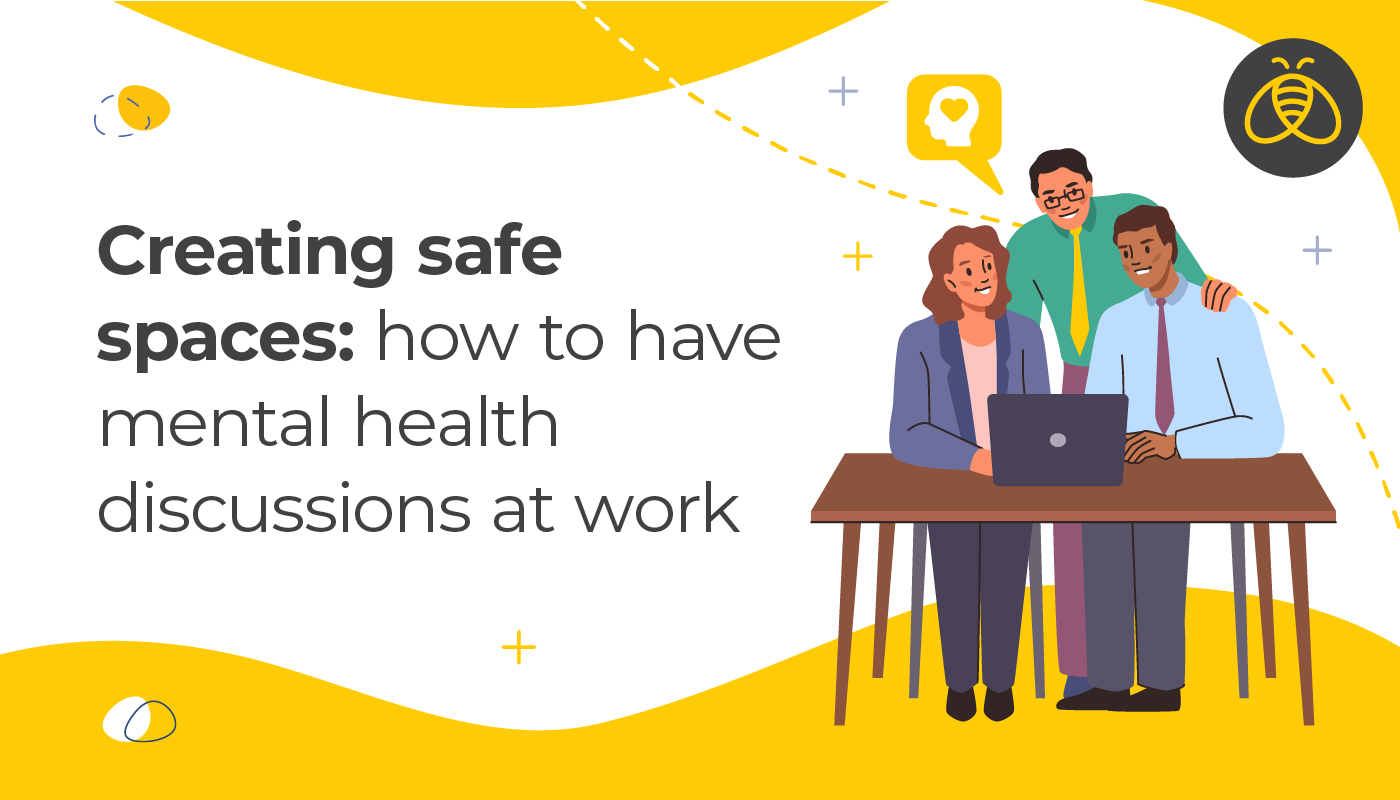Creating safe spaces: how to have mental health discussions at work
By: Benefits by Design | Tuesday February 11, 2025
Updated : Monday February 10, 2025
Talking about mental health at work is no longer a taboo. Companies worldwide recognize the power of prioritizing mental well-being, understanding that a happy mind leads to a thriving environment. This growing awareness has sparked a cultural shift where employees are encouraged to share their challenges without fear of judgment.
Engaging in mental health discussions at work produces tangible benefits for employees and enterprises. It creates a supportive workplace that fosters trust, creativity, and teamwork. Relationships also improve as colleagues understand and empathize with each other’s experiences.
This article explores how to create these safe spaces for mental health discussions, offering actionable insights. Together, we can build workplaces where every voice matters, and well-being is a collective priority.
Workplace stressors that impact mental health
Workplace stress can stem from various factors
- Unclear expectations in roles and responsibilities often leave employees feeling anxious and unsure, leading to unnecessary stress.
- Toxic environments, fueled by bullying, gossip, or poor communication, significantly harm mental well-being and hinder collaboration.
- Workload overload – employees juggling excessive tasks experience burnout, which diminishes productivity and morale.
- A lack of recognition for achievements creates dissatisfaction, as individuals feel undervalued despite their efforts.
- Job insecurity, stemming from layoffs or vague communication about company stability, adds another layer of anxiety that can disrupt focus and performance.
- Relocation to a new environment can also be a significant stressor, especially when employees face insufficient support during such transitions. Companies must provide clear guidance and assistance to help employees avoid stress during the move and easily settle into new responsibilities. Offering transitional assistance can ease this burden.
The role of leaders in creating safe spaces
Leaders are responsible for shaping supportive workplaces. They must foster empathy and understanding to set the tone for open and respectful communication. Fostering empathy starts with active listening. Leaders who genuinely hear their team members’ concerns create trust and encourage transparency. Acknowledging struggles or asking thoughtful questions can make employees feel valued and supported.
Training is another essential aspect. Equipping leaders with tools to address mental health topics ensures they respond appropriately and confidently. Workshops and resources focused on understanding stress, burnout, and other mental health challenges enable them to approach conversations sensitively.
Proactive leadership strengthens relationships, increases engagement, and creates a workplace where everyone feels safe and empowered. Leaders’ actions influence workplace culture, showing employees that seeking help is not a sign of weakness.

Practical steps for initiating mental health discussions at work
Starting conversations about mental well-being requires thoughtful preparation and consistent effort. To begin, focus on creating a framework that supports open dialogue. Consider these practical steps:
- Create clear policies supporting mental well-being: Draft policies prioritizing mental health, such as flexible work hours or mental health leave. Ensure these are communicated effectively to the entire team.
- Designate mental health ambassadors or support groups: Select team members trained to offer guidance or lead initiatives focused on well-being. These ambassadors act as approachable resources for employees seeking advice or support.
- Promote resources such as counseling or Employee Assistance Programs (EAPs): Sharing information about accessible services, including counseling or EAPs, ensures employees know how to seek help.
Taking these steps creates a culture where mental health discussions at work are normalized. They demonstrate a commitment to building a healthier, more understanding workplace.
Using empathy to encourage open communication
Empathy is a powerful tool for encouraging open communication in the workplace. Active listening is a fundamental aspect of this process. It involves giving your full attention, avoiding interruptions, and responding thoughtfully to what’s being said. Repeating or summarizing what you’ve heard shows you value the speaker’s words, reinforcing trust and openness.
To show genuine care, ask thoughtful, nonjudgmental questions that encourage deeper sharing. Simple phrases like “I appreciate you sharing this” or “How can I support you?” help create a positive and supportive atmosphere. Maintaining eye contact and using open body language also signals attentiveness and empathy.
Approaching conversations with compassion and understanding helps employees feel respected and valued. Over time, this practice strengthens workplace relationships, reduces stigma, and promotes a culture where mental health discussions feel natural.

What not to do during mental health discussions
It is just as important to approach mental health discussions with care as it is to initiate them. Missteps during these conversations can undermine trust and discourage openness.
Avoid using dismissive language or minimizing someone’s feelings. Phrases like “It’s not that bad” or “Just push through it” can invalidate their experiences. Instead, focus on listening without judgment or offering unsolicited advice. Jumping to solutions can make someone feel unheard, so wait until they ask for suggestions before providing input.
Confidentiality is another non-negotiable aspect of these discussions. Sharing someone’s personal experiences without their permission breaches trust and can create discomfort or reluctance to seek help in the future. Always approach these matters with the utmost respect and discretion.
Common mistakes also include rushing the conversation or appearing distracted. Mental health topics require patience and full attention. Make the individual feel valued by dedicating the time and focus they need.
How to handle challenges during mental health discussions
Navigating challenges during mental health discussions requires a thoughtful and measured approach. Resistance, strong emotions, and complex situations are common. However, they can be addressed effectively with preparation and care.
Resistance from employees or management may stem from stigma or fear of judgment. Address this by emphasizing the importance of these discussions and framing them as beneficial for everyone involved. Building trust and demonstrating genuine concern can help reduce hesitancy.
Strong feelings, such as anger or frustration, may arise during conversations. Respond calmly and empathically. Validating how someone feels often helps de-escalate tension and fosters a supportive environment.
There are times when situations exceed the capacity of workplace resources. Knowing when to seek professional guidance or mediation is essential. Collaborating with mental health professionals guarantees you will handle conversations appropriately and provides the necessary expertise to address complex issues.
Conclusion
Creating supportive workplaces begins with open and honest communication. Encouraging mental health discussions at work helps break down stigma and builds trust among team members. These conversations are not just about solving immediate problems—they lay the foundation for long-term growth and well-being. By prioritizing these efforts, workplaces can become environments where everyone feels valued, heard, and empowered to thrive together.


